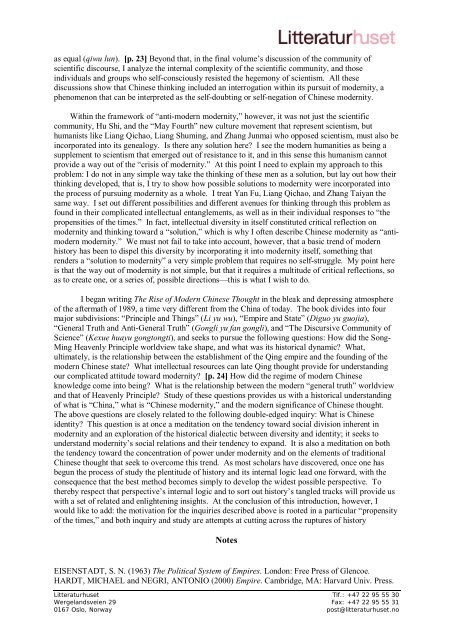20 2011 Opening speech by Prof. Wang Hui ... - Litteraturhuset
20 2011 Opening speech by Prof. Wang Hui ... - Litteraturhuset
20 2011 Opening speech by Prof. Wang Hui ... - Litteraturhuset
Create successful ePaper yourself
Turn your PDF publications into a flip-book with our unique Google optimized e-Paper software.
as equal (qiwu lun). [p. 23] Beyond that, in the final volume’s discussion of the community ofscientific discourse, I analyze the internal complexity of the scientific community, and thoseindividuals and groups who self-consciously resisted the hegemony of scientism. All thesediscussions show that Chinese thinking included an interrogation within its pursuit of modernity, aphenomenon that can be interpreted as the self-doubting or self-negation of Chinese modernity.Within the framework of “anti-modern modernity,” however, it was not just the scientificcommunity, Hu Shi, and the “May Fourth” new culture movement that represent scientism, buthumanists like Liang Qichao, Liang Shuming, and Zhang Junmai who opposed scientism, must also beincorporated into its genealogy. Is there any solution here? I see the modern humanities as being asupplement to scientism that emerged out of resistance to it, and in this sense this humanism cannotprovide a way out of the “crisis of modernity.” At this point I need to explain my approach to thisproblem: I do not in any simple way take the thinking of these men as a solution, but lay out how theirthinking developed, that is, I try to show how possible solutions to modernity were incorporated intothe process of pursuing modernity as a whole. I treat Yan Fu, Liang Qichao, and Zhang Taiyan thesame way. I set out different possibilities and different avenues for thinking through this problem asfound in their complicated intellectual entanglements, as well as in their individual responses to “thepropensities of the times.” In fact, intellectual diversity in itself constituted critical reflection onmodernity and thinking toward a “solution,” which is why I often describe Chinese modernity as “antimodernmodernity.” We must not fail to take into account, however, that a basic trend of modernhistory has been to dispel this diversity <strong>by</strong> incorporating it into modernity itself, something thatrenders a “solution to modernity” a very simple problem that requires no self-struggle. My point hereis that the way out of modernity is not simple, but that it requires a multitude of critical reflections, soas to create one, or a series of, possible directions—this is what I wish to do.I began writing The Rise of Modern Chinese Thought in the bleak and depressing atmosphereof the aftermath of 1989, a time very different from the China of today. The book divides into fourmajor subdivisions: “Principle and Things” (Li yu wu), “Empire and State” (Diguo yu guojia),“General Truth and Anti-General Truth” (Gongli yu fan gongli), and “The Discursive Community ofScience” (Kexue huayu gongtongti), and seeks to pursue the following questions: How did the Song-Ming Heavenly Principle worldview take shape, and what was its historical dynamic? What,ultimately, is the relationship between the establishment of the Qing empire and the founding of themodern Chinese state? What intellectual resources can late Qing thought provide for understandingour complicated attitude toward modernity? [p. 24] How did the regime of modern Chineseknowledge come into being? What is the relationship between the modern “general truth” worldviewand that of Heavenly Principle? Study of these questions provides us with a historical understandingof what is “China,” what is “Chinese modernity,” and the modern significance of Chinese thought.The above questions are closely related to the following double-edged inquiry: What is Chineseidentity? This question is at once a meditation on the tendency toward social division inherent inmodernity and an exploration of the historical dialectic between diversity and identity; it seeks tounderstand modernity’s social relations and their tendency to expand. It is also a meditation on boththe tendency toward the concentration of power under modernity and on the elements of traditionalChinese thought that seek to overcome this trend. As most scholars have discovered, once one hasbegun the process of study the plentitude of history and its internal logic lead one forward, with theconsequence that the best method becomes simply to develop the widest possible perspective. Tothere<strong>by</strong> respect that perspective’s internal logic and to sort out history’s tangled tracks will provide uswith a set of related and enlightening insights. At the conclusion of this introduction, however, Iwould like to add: the motivation for the inquiries described above is rooted in a particular “propensityof the times,” and both inquiry and study are attempts at cutting across the ruptures of historyNotesEISENSTADT, S. N. (1963) The Political System of Empires. London: Free Press of Glencoe.HARDT, MICHAEL and NEGRI, ANTONIO (<strong>20</strong>00) Empire. Cambridge, MA: Harvard Univ. Press.<strong>Litteraturhuset</strong> Tlf.: +47 22 95 55 30Wergelandsveien 29 Fax: +47 22 95 55 310167 Oslo, Norway post@litteraturhuset.no



